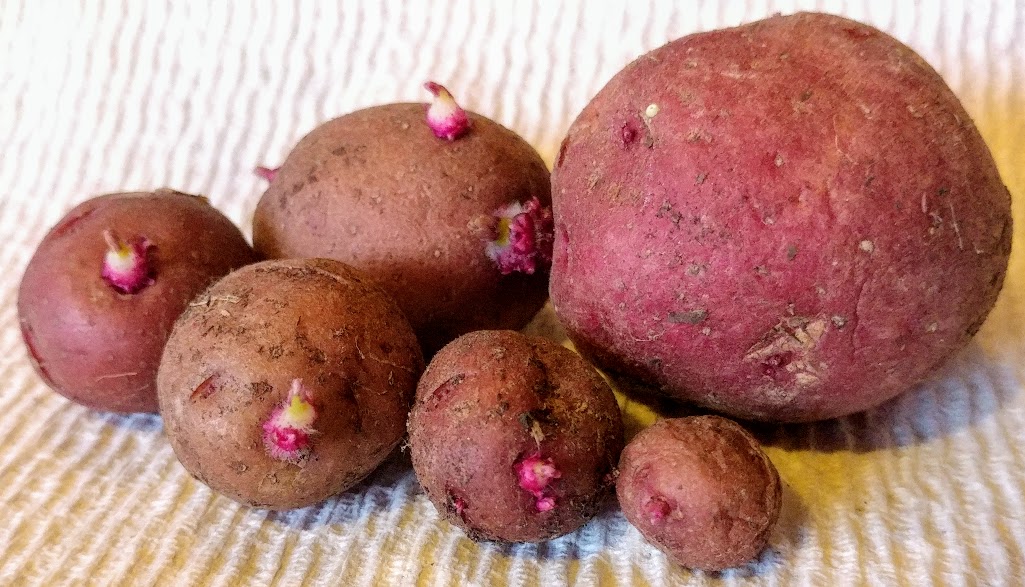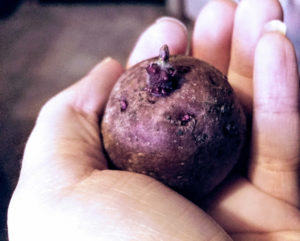Growing potatoes can be an excellent educational experience for children, and a great way to satisfy an adult’s curiosity. Believe it or not, potato plants can be VERY easy to grow!
How to Start a Potato Plant
 Before you begin, you will need a potato to start with. Whether you choose a bag of beautiful, specialty organic seed potatoes or an old, cheap russet that has started to sprout in the back of your pantry, chances are you’ll wind up with a healthy potato plant. Gather up your tubers and lets go!
Before you begin, you will need a potato to start with. Whether you choose a bag of beautiful, specialty organic seed potatoes or an old, cheap russet that has started to sprout in the back of your pantry, chances are you’ll wind up with a healthy potato plant. Gather up your tubers and lets go!
Chitting (or Sprouting) the Potato
 Set the potato in a warm, bright place to encourage sprouting; that is, if the potato hasn’t already started the process in your pantry. It may take a week or two (sometimes longer for fresh tubers) before you see small buds. Do not allow the sprouts to exceed 1 inch in length, and ensure that they are short and thick. This promotes a strong, healthy stem and root system. You could also toss an unsprouted potato straight into some dirt, but it may take several weeks before any sprouts are seen breaking through the dirt. Chitting makes the process move along a bit faster, while ensuring that the potato is alive.
Set the potato in a warm, bright place to encourage sprouting; that is, if the potato hasn’t already started the process in your pantry. It may take a week or two (sometimes longer for fresh tubers) before you see small buds. Do not allow the sprouts to exceed 1 inch in length, and ensure that they are short and thick. This promotes a strong, healthy stem and root system. You could also toss an unsprouted potato straight into some dirt, but it may take several weeks before any sprouts are seen breaking through the dirt. Chitting makes the process move along a bit faster, while ensuring that the potato is alive.
Planting the Potato Sprout
 Potatoes can be planted in both containers and gardens. They truly are not picky, as long as they get nutrition and sunlight. If the potato is to be planted in a container, it should have a 5 gallon capacity. The plant must be protected from frost as well, if you intend on getting any potatoes from it.
Potatoes can be planted in both containers and gardens. They truly are not picky, as long as they get nutrition and sunlight. If the potato is to be planted in a container, it should have a 5 gallon capacity. The plant must be protected from frost as well, if you intend on getting any potatoes from it.
Where ever you choose to plant the spud, be sure that it has at least 2″ of soil under the seed potato. Cover the sprout to a depth of 4 inches. It does not take very long for a young sprout to erupt from the soil, and they tend to grow fairly quickly. Give the seed potato one watering after planting; only water again before it emerges if the soil becomes dry.
Caring For the Young Plant
 As the tiny potato plant emerges, you will notice that it grows faster and faster with each passing day.
As the tiny potato plant emerges, you will notice that it grows faster and faster with each passing day.
Potato plants can get fairly large; don’t be surprised if it exceeds 24 inches in height. The plant will need plenty of phosphorous and potassium to form optimum tubers during its life cycle, so a bit of the right fertilizer could most definitely help. The plant should receive as much full sun as possible.
The less sun it receives, the leggier and less bushy the plant will become.
Why Is My Potato Plant Dying?
Potato plants will die for a variety of reasons. First, check for any pest damage such as holes in leaves or cut stems. There are many pests, including slugs and potato beetles, who will devour potato plants. Next, check for signs of fungal or bacterial infections. Late blight can be a big problem; check for curling, browned leaves. Powdery mildew appears as a white dusting on the leaves.
 Potato plants may also die off with lack of proper care. If a plant is not receiving enough water, it is going to wilt and die. Lack of sunlight could result in stunted growth, and later death as the plant struggles to survive. Poor soil with few nutrients will not offer the potato plant the nutrients it needs to grow, which is why I highly recommend enriched compost or a quality potting mix.
Potato plants may also die off with lack of proper care. If a plant is not receiving enough water, it is going to wilt and die. Lack of sunlight could result in stunted growth, and later death as the plant struggles to survive. Poor soil with few nutrients will not offer the potato plant the nutrients it needs to grow, which is why I highly recommend enriched compost or a quality potting mix.
And finally, potato plants die after about 3 months, as their life cycles end. The plant flourishes and dies fairly rapidly; once flowers have blossomed, the tubers begin to fatten up and store more energy. After the tubers have prepared for dormancy, the plants die. Thus, it’s time to harvest!